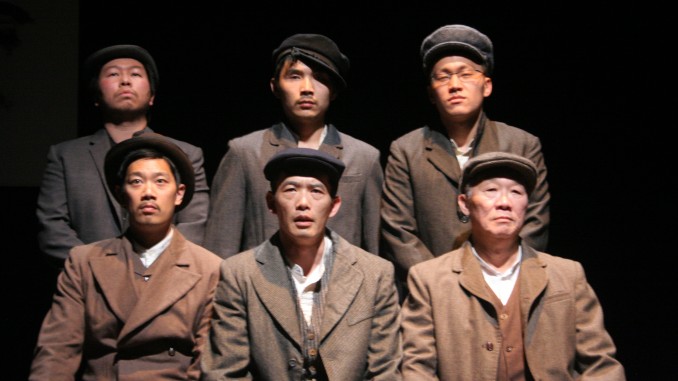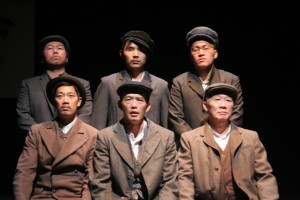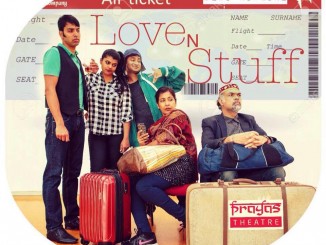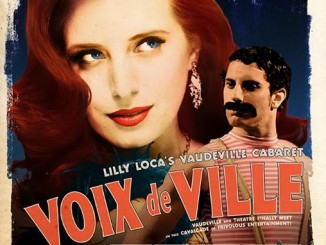
Feeding the Past [by James Wenley]

I first encountered playwright Renee Liang’s The Bone Feeder in 2009, presented as part of her postgraduate diploma of Arts at the University of Auckland, which I reviewed for Craccum Magazine.
Since then, Renee (known also for plays Lantern & The First Asian AB) has continued to develop and work on the play. More productions followed, and now it makes it’s fully fledged professional debut at TAPAC directed by Lauren Jackson, with a cast of ten, 4 live musicians, and even martial arts wire work.
The initial season of The Bone Feeder was the first time I had been exposed to a little known tragedy in early Chinese history in New Zealand, which has ongoing echoes today. The Gold Rush saw a wave of Chinese migration to New Zealand, many working to send back money to their families at home. Liang says they considered themselves “temporary visitors”, hoping to return one day. Many didn’t, and the remains of 499 deceased Chinese miners were to return home to China in 1902 on the SS Ventor. The miners however were never able to be reunited with their families, the Ventor sinking in the Hokianga Harbour.
The title refers to the cultural practice of ‘feeding the bones’ – offering sacrifices of food and drink to the graves of ancestors. (A behind-the-scenes blog post reveals that the title had an unattended consequence: their Chinese translation meant ‘The Zombie Bone Feeders’ – a play I wouldn’t mind seeing actually).
The story of the Ventnor’s cargo is an incredibly poignant one, not least considering the shameful treatment of the early Chinese settlers. There’s an interesting Maori connection too, Maori adopting washed up bones and burying them in their family urapa. Renee takes this history and movingly blends this past with the fictional as Ben, a fifth-generation Chinese-kiwi, travels to the Hokianga looking for the bones of his ancestor.
It’s interesting for me to revisit my original review [I’ll post it below in comments] to see how much the play has benefitted from ongoing work and development. While the heart of the story is the same, in many ways it’s an entirely different play. The early version concentrated its attention on Ben, with “much of the conflict in the play… contrived through external barriers that impede Ben’s ability to even get out to the harbor”, and I wrote then that Renee had a ‘gem’ but more finessing of the story to do. In the new version, this gem is a bright and shiny pounamu, Renee confident in her story and themes.
The focus is on both Ben (Kevin Ng), struggling with reconnecting with his family history, and his ancestor Kwan (Gary Young – usually cast as the ‘criminal Asian’ in Underbelly NZ and Outrageous Fortune). The play is richer for its exploration of Kwan’s emotional life and displacement in a foreign land. We see his backstory; his life in Canton, his marriage night, and leaving his wife for the opportunities (and temptations) of New Zealand in the 1800s. In Kwan, the 499 bones are humanised, and we feel the weight of the loss.
An ensemble of ghosts of the Chinese Miners haunt the Hokianga, and the trio of Wang, Dan, and Sam (Charles Chan, Llanyon Eli Joe and Willie Ying) provide appealing Three Stooges comic humour as they bicker.
The Ferryman, a throw-away character in Renee’s original, is given mana as the Maori connection to the Ghosts, and helps Ben along in his quest. Played by Rob Mokaraka with empathy and quietly wicked humour, he’s a big part of grounding the fantastical elements in the believable.
There’s an interesting fusion of Western and Eastern in telling the story, director Lauren Jackson working hard to marry song, movement, magic realism, shadow play and martial arts into a cohesive whole. Together with Jackson and the choreographers, the ensemble work with an with an impressive physical language that complements the poeticism of the playwright’s words .
The music, a fusion mix of percussion, Ghuzeng, Taonga Puoro and Chinese Flute, provides an evocative score to the action, lifting the audience through time and cultures. Walking past the musician’s corner, I’m impressed by the exotic array of instruments; speaking to Musical Director Andrew Correa, he himself didn’t know how many instruments the 4-person band played during the show, such were the number.
The inclusion of the martial arts wire work by Dragon Origin, thought to be the first for a professional New Zealand play, didn’t fill its promise or potential. While the stunt teams work is not to be faulted (a whole heap of crew arrive from backstage for the curtain call – it takes more people than one would think to make an actor fly onstage), the device itself was little utilised, and didn’t add anything extra to the storytelling, other than as a moderately cool effect. Martial Arts seem somewhat shoehorned into the story. Each time the wire was used, I felt immediately taken out of the world of the play. They needed to either find a more urgent way to use the technique, or jettison it altogether.
While the play is well-plotted and characters well-fleshed, the climax suffers from a surprising rush and lack of clarity. Without wishing to give anything away, I was left scratching my head as to what had happened to Ben and why some harm had come to him. Because of this confusion I was left cold during a moment that was intended to be emotional. While by no means spoiling my appreciation for the rest of the play, and acknowledging that a certain amount of ambiguity is a good thing, the climax certainly would have benefited from more coherency, especially the physical action.
The play gives a lot to feed on for its audiences. Starting with the historical event, the play delves into the fascinating issues of belonging and the immigrant experience and is a potent theatrical coming together of Kiwi, Maori and Chinese cultures. Arguably, the land and a sense of ‘place’ is one of the most integral parts of the New Zealand identity, both in Maori culture and Pakeha colonialism (Land Wars anyone?). But where do other immigrants fit? The Bone Feeder invokes a hopeful immigration story where immigrants can remain connected to their homelands, but also come to feel a part of this land.
The Bone Feeder plays at TAPAC Theatre until 20th November. More information at http://www.bonefeeder.com/index.html




My Original Review of the 2009 development season at University of Auckland’s Drama Studio. Printed in Craccum Magzine:
Review: The Bone Feeder
By James Wenley
Through the year you’ll find a couple of theatrical gems performed at the black box Drama Studio on our very own campus. The Bone Feeder, written and directed by Renee Liang as part of her Postgraduate Diploma in Arts is one such work. It is a hauntingly evocative work inspired by a tragic event in the largely unknown history of the Chinese in New Zealand.
Mike Ginn confidently plays Ben, who has arrived in the Hokianga to find the bones of his ancestors. The remains of 499 Chinese were on board the SS Ventor, bound for their families in China. But they never made it, the ship struck rocks in the Hokianga Harbour and the remains were lost. Ben is on a quest to find them.
Much of the conflict in the play is contrived through external barriers that impede Ben’s ability to even get out to the harbor. Ben is plunged into a hellish surreal New Zealand. He encounters three very caricatured pot-heads who offer him “hokianga hooch” and then mug him. Gareth Tiopiri-Waaka has a brilliant turn as a tour guide who takes Ben in the wrong direction, and then again as a ferry man who throws him off the boat. These obstacles, though entertaining, do strike me as slightly arbitrary, and would have liked to see Ben’s internal conflict (or intergenerational conflict with his sick father on the phone amped up). Ben Teh is charming as the waddling old ghost Kwann who watches over Ben, and who we later discover is one of his ancestors.
The play is accompanied by a traditional Chinese band New Nature with a score composed by Andrew Correa (who is also an impressive actor in the piece in his own right). It added an added spirit and magic to story and was very beautiful. The set is simple with a painted ocean floor and a ramp at the back. Small ships and birds are occasionally carried across the stage by the actors. UV lights and fish masks make an underwater scene quite stunning. I found these elements very striking, and wished they had been pushed stylistically even further. Even more of a physical theatre style, which it began to employ, would have made the production stronger.
Sometimes I felt the scenes lingered slightly too long, and the “moral of the story” message at the end a little too easy. I found the story quite fascinating, and Renee has a mastery of the poetic. Bone Feeder shone a light on a largely unknown historical event, and it’s fascinating to see the intersection of kiwi, Chinese, and Maori stories. There is perhaps a little more finessing of the story that needs doing, but Renee certainly does have a gem here.